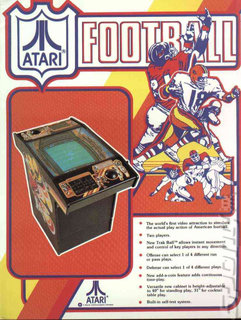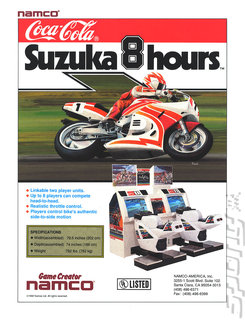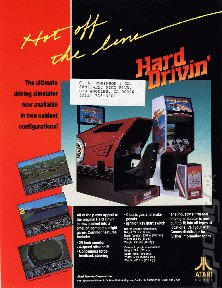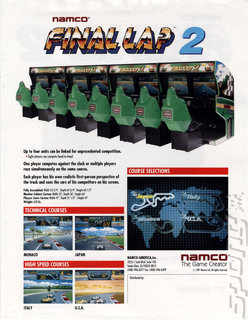Continuing the second part in this monthís amusement coverage, I continue to look at the innovation that separates coin-op from consumer.
Atari, a long lamented name from the American amusement industryís history, sadly brutalized, passed from pillar to post, Ďtil recently sidelined as a brand label to offer failing publisher respectability was, in its heyday an innovative arcade champion. It was Atari that deployed the first force-feedback steering device with the seminal title Hard Driviní (1988). It would not be long before consumer peripheral manufacturers would rush to emulate this for home release.
The first trackball arcade game, Atari Football (1978) would go on to fuel the imagination and play its part in the development of the mouse. The first 3D graphics, again from Atari, with i-Robot (1983) would engender a new generation of visual representation, which would be emulated by other manufactures such as Namco. Though an innovative developer from the Japanese factory system, it also has to be remembered that Namco once owned the arcade division of Atari and learned much from its close links. But it is the innovation it has brought to how we play in the arcades that has shaped so much of the consumer scene.
Innovation such as Final Lap (1987), the first multiplayer (network) driving game saw an eight-player Pole Position; the network play element - offering multiple playing opponent experiences - would shape gaming forever. With success of Suzuka 8 Hours in 1992, the company originated a complete motorbike interface to ride - a popular feature even today with games such as Fast and Furious: SuperBikes last year.
But it is with unique gaming experiences that Namco shines. Galaxian 3, first launched in 1994, took the concept of a cinema-style narrative with interactive six-player shooter theatre. In taking the humble shooting game experience, Namco added the ''Duck Pedal' and the 1995 smash Time Crisis was born. However, not all of the companyís concepts have found worldwide reputation. The 1997 horse riding simulator Final Furlong was a quirky game more suited to Japanese playing styles - that said the Wii may soon see a rebirth in this frenetic style of play.
The people who feel that the next-generation Nintendo Wii console represents innovation, forget that the arcade has been there first. This concept was proven first with games such as SEGAís bizarre Pharaoh shooter The Maze of the King (2002), Konamiís sword game Blade of Honor (2001), or table tennis Nice Smash (2002). How many of these coin-op games will be recycled for the consumer sector now the technology has caught up is another question.
As previously covered in this series of SPOnG.com arcade features, the number of consumer titles that are finding a home in amusement has skyrocketed since Electronic Arts first supported Global VR's adaptation of the PGA Golf property.
Not all traffic has been one way - one of the untold stories of amusement evolution is that the popularity of the Sport Shooting game owes more than a passing nod to the consumer sector. For amusement the Big Buck series of elk, deer and buffalo blasting has proven a sports bar main-stay title. At least four manufacturers have developed their own series of games based on a simple premise, while Incredible Technologies, SEGA America and Raw Thrills have tournament-connected games that offer big prize payouts for dead-eyed marksmen.
But it is the passing resemblance with the Infogrames super-successful title Deer Hunter, by WizardWorks in 1997, that started the whole genre rolling. The idea of deer-blasting in a videogame environment was taken one step further by the ability of the amusement release to incorporate a realistic pump action shotgun, rather than frantic mouse action - and so was born an amusement success story.
Shotgun blasting coin-op action such as Atari's Qwak! in 1974 would usher in gun interfaces and inspire Nintendo's Duck Hunt (a name borrowed from a Sega Electro-Mechanical arcade game from the 60ís).
One of the biggest separations from amusement and consumer application is the tournament environment. Where the hurdle of legislation and feasibility has seen actual tournament gaming for money excluded from XBox LIVE and competitive console networks, arcades actually pay out top dollar 24/7 to loyal gamers. The recent Golden Tee golf World Championship in Las Vegas saw $57,000 prize pool up for grabs by the 16 of the best players - facilities having seen revenue of $1 million generated by players hoping to compete. Now say amusement isnít profitable!
Read the first part here.
About the author: Kevin Williams is founder and director of the out-of-home leisure entertainment consultancy KWP Limited. His extensive years in the global video amusement and hi-tech attractions industry includes top management and design posts, with special focus on new technology development and applications. A well-known speaker on the industry and its technology, he pens an extensive number of articles. Founder and publisher of The Stinger Report - a popular industry e-Newsletter and web-based information service.

Atari, a long lamented name from the American amusement industryís history, sadly brutalized, passed from pillar to post, Ďtil recently sidelined as a brand label to offer failing publisher respectability was, in its heyday an innovative arcade champion. It was Atari that deployed the first force-feedback steering device with the seminal title Hard Driviní (1988). It would not be long before consumer peripheral manufacturers would rush to emulate this for home release.
The first trackball arcade game, Atari Football (1978) would go on to fuel the imagination and play its part in the development of the mouse. The first 3D graphics, again from Atari, with i-Robot (1983) would engender a new generation of visual representation, which would be emulated by other manufactures such as Namco. Though an innovative developer from the Japanese factory system, it also has to be remembered that Namco once owned the arcade division of Atari and learned much from its close links. But it is the innovation it has brought to how we play in the arcades that has shaped so much of the consumer scene.
Innovation such as Final Lap (1987), the first multiplayer (network) driving game saw an eight-player Pole Position; the network play element - offering multiple playing opponent experiences - would shape gaming forever. With success of Suzuka 8 Hours in 1992, the company originated a complete motorbike interface to ride - a popular feature even today with games such as Fast and Furious: SuperBikes last year.
But it is with unique gaming experiences that Namco shines. Galaxian 3, first launched in 1994, took the concept of a cinema-style narrative with interactive six-player shooter theatre. In taking the humble shooting game experience, Namco added the ''Duck Pedal' and the 1995 smash Time Crisis was born. However, not all of the companyís concepts have found worldwide reputation. The 1997 horse riding simulator Final Furlong was a quirky game more suited to Japanese playing styles - that said the Wii may soon see a rebirth in this frenetic style of play.
The people who feel that the next-generation Nintendo Wii console represents innovation, forget that the arcade has been there first. This concept was proven first with games such as SEGAís bizarre Pharaoh shooter The Maze of the King (2002), Konamiís sword game Blade of Honor (2001), or table tennis Nice Smash (2002). How many of these coin-op games will be recycled for the consumer sector now the technology has caught up is another question.
As previously covered in this series of SPOnG.com arcade features, the number of consumer titles that are finding a home in amusement has skyrocketed since Electronic Arts first supported Global VR's adaptation of the PGA Golf property.
Not all traffic has been one way - one of the untold stories of amusement evolution is that the popularity of the Sport Shooting game owes more than a passing nod to the consumer sector. For amusement the Big Buck series of elk, deer and buffalo blasting has proven a sports bar main-stay title. At least four manufacturers have developed their own series of games based on a simple premise, while Incredible Technologies, SEGA America and Raw Thrills have tournament-connected games that offer big prize payouts for dead-eyed marksmen.
But it is the passing resemblance with the Infogrames super-successful title Deer Hunter, by WizardWorks in 1997, that started the whole genre rolling. The idea of deer-blasting in a videogame environment was taken one step further by the ability of the amusement release to incorporate a realistic pump action shotgun, rather than frantic mouse action - and so was born an amusement success story.
Shotgun blasting coin-op action such as Atari's Qwak! in 1974 would usher in gun interfaces and inspire Nintendo's Duck Hunt (a name borrowed from a Sega Electro-Mechanical arcade game from the 60ís).
One of the biggest separations from amusement and consumer application is the tournament environment. Where the hurdle of legislation and feasibility has seen actual tournament gaming for money excluded from XBox LIVE and competitive console networks, arcades actually pay out top dollar 24/7 to loyal gamers. The recent Golden Tee golf World Championship in Las Vegas saw $57,000 prize pool up for grabs by the 16 of the best players - facilities having seen revenue of $1 million generated by players hoping to compete. Now say amusement isnít profitable!
Read the first part here.
About the author: Kevin Williams is founder and director of the out-of-home leisure entertainment consultancy KWP Limited. His extensive years in the global video amusement and hi-tech attractions industry includes top management and design posts, with special focus on new technology development and applications. A well-known speaker on the industry and its technology, he pens an extensive number of articles. Founder and publisher of The Stinger Report - a popular industry e-Newsletter and web-based information service.

Read More Like This
Comments
The first trackball arcade game, Atari Football (1978) would go on to fuel the imagination and play its part in the development of the mouse.
I know you are trying hard to prove your point of innovation, but I actually burst out laughing at that one!
From the exceptionally easy to find Computer Mouse entry in Wikipedia - 'Douglas Engelbart of the Stanford Research Institute invented the mouse in 1964 after extensive usability testing.' and 'Engelbart received patent US3541541 on November 17, 1970 for an "X-Y Position Indicator for a Display System".' or even 'Bill English, builder of the original mouse, invented the so-called ball mouse in 1972 while working for Xerox PARC.'
I'd have thought that 1972, 1970 and 1964 would count as being before 1978, even if we are "favoring the establishing of the concept" and not just taking the invention point. Xerox PARC was the institution that "inspired" Apple to include the mouse along with the Lisa and the Mac after all. And that was the point that mouse controllers really entered the public imagination.
Also by stating the following;
The people who feel that the next-generation Nintendo Wii console represents innovation, forget that the arcade has been there first. This concept was proven first with games such as SEGAís bizarre Pharaoh shooter The Maze of the King (2002), Konamiís sword game Blade of Honor (2001), or table tennis Nice Smash (2002).
You are totally ignoring the Dreamcast's fishing rod controller that could be used to simulate swordplay in Soul Calibur - a game that was released, to great acclaim, in 1999.
Just a little correction - you comment about the Dreamcast fishing rod. That was based on the 'Get Bass' arcade game interface!
You seem to be more interested in proving your point than what the author is writing?
You seem to be more interested in proving your point than what the author is writing?
more comments below our sponsor's message
sega999 wrote:
Just a little correction - you comment about the Dreamcast fishing rod. That was based on the 'Get Bass' arcade game interface!
You seem to be more interested in proving your point than what the author is writing?
You seem to be more interested in proving your point than what the author is writing?
If the writer had used the arcade version of "Get Bass" as his example of motion sensing innovation, I couldn't have called him on it, however he used examples that were preceded by console games. That he missed an earlier arcade example is not my problem.
One of those finest arcade moments saw Dr Dee, Tyrion and some of his friends and myself in Soho's Namco World late one night after a several pints of Europe's finest fighting-strength lager.
Imagine several grown men, three sheets to the wind, playing Final Furlong for all their worth. I think you'd be hard pushed to find anything more entertaining to leave you sweaty and heaving in Soho.
Imagine several grown men, three sheets to the wind, playing Final Furlong for all their worth. I think you'd be hard pushed to find anything more entertaining to leave you sweaty and heaving in Soho.









